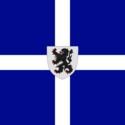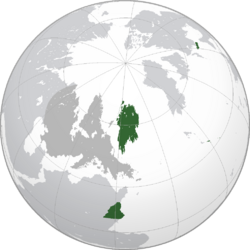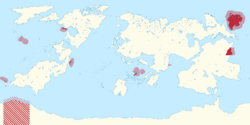Neragon: Difference between revisions
Philimania (talk | contribs) mNo edit summary |
Philimania (talk | contribs) mNo edit summary |
||
| Line 93: | Line 93: | ||
Neragon's history can be traced back to its early tribal origins, when various clans and groups inhabited the region around what is now [[Aialand]]. These disparate communities often engaged in tribal conflicts and resource competition. However, the turning point came with the unification of these tribes under the leadership of King [[Aldor the Great]] in 94 CE. Aldor's reign marked the beginning of the [[Kingdom of Aialand]], establishing the central authority that laid the foundation for the nation's governance and culture. Over the centuries, Neragon faced numerous challenges, including external invasions and internal strife, such as the !Roman invasion in 150 CE, which ended in a !Roman stronghold in the west of the country. | Neragon's history can be traced back to its early tribal origins, when various clans and groups inhabited the region around what is now [[Aialand]]. These disparate communities often engaged in tribal conflicts and resource competition. However, the turning point came with the unification of these tribes under the leadership of King [[Aldor the Great]] in 94 CE. Aldor's reign marked the beginning of the [[Kingdom of Aialand]], establishing the central authority that laid the foundation for the nation's governance and culture. Over the centuries, Neragon faced numerous challenges, including external invasions and internal strife, such as the !Roman invasion in 150 CE, which ended in a !Roman stronghold in the west of the country. | ||
The monarchy remained a central institution throughout most of the medieval period, though it transitioned into a constitutional monarchy in 1298 CE, when King [[Thomas I]] signed the [[Grand Accord]], granting certain rights and privileges to the noble class. This marked a significant step toward a more balanced and equitable society. The !Roman stronghold in the west persisted for centuries even after the fall of the empire, serving as a constant reminder of external threats as the [[Kingdom of Ostwng]]. Additionally, internal conflicts occasionally flared up, with periodic disputes between the monarchy and nobility over the distribution of power and resources. Aialand ceased to exist as a country in 1548 when it absorbed the larger but less populated [[Kingdom of Tirnikt]] to the north. This event marked the end of Aialand as an independent country, establishing the Kingdom of Neragon in Wilding. The Kingdom of Ostwng would later be annexed by Neragon in 1675, finally ending the long-standing !Roman presence in the region. | The monarchy remained a central institution throughout most of the medieval period, though it transitioned into a constitutional monarchy in 1298 CE, when King [[Thomas I, King of Neragon|Thomas I]] signed the [[Grand Accord]], granting certain rights and privileges to the noble class. This marked a significant step toward a more balanced and equitable society. The !Roman stronghold in the west persisted for centuries even after the fall of the empire, serving as a constant reminder of external threats as the [[Kingdom of Ostwng]]. Additionally, internal conflicts occasionally flared up, with periodic disputes between the monarchy and nobility over the distribution of power and resources. Aialand ceased to exist as a country in 1548 when it absorbed the larger but less populated [[Kingdom of Tirnikt]] to the north. This event marked the end of Aialand as an independent country, establishing the Kingdom of Neragon in Wilding. The Kingdom of Ostwng would later be annexed by Neragon in 1675, finally ending the long-standing !Roman presence in the region. | ||
Throughout the 18th and 19th centuries, Neragon experienced significant {{wp|industrialisation}} and {{wp|modernisation}}, as well as growth as a {{wp|colonial power}}. The development of {{wp|railway}}s, {{wp|factories}}, and {{wp|urban centres}} transformed the nation into an industrial power. The Neragese monarchy gradually ceded more authority to elected representatives, leading to the establishment of a {{wp|parliamentary system}} in 1831. This shift in governance brought about greater political stability and representation for the growing population. The 20th century brought its own set of challenges to Neragon, with their involvement in the [[Great War (Gentu II)|Great War]], Neragon emerged briefly as the world superpower before the beginning of the !Cold War. | Throughout the 18th and 19th centuries, Neragon experienced significant {{wp|industrialisation}} and {{wp|modernisation}}, as well as growth as a {{wp|colonial power}}. The development of {{wp|railway}}s, {{wp|factories}}, and {{wp|urban centres}} transformed the nation into an industrial power. The Neragese monarchy gradually ceded more authority to elected representatives, leading to the establishment of a {{wp|parliamentary system}} in 1831. This shift in governance brought about greater political stability and representation for the growing population. The 20th century brought its own set of challenges to Neragon, with their involvement in the [[Great War (Gentu II)|Great War]], Neragon emerged briefly as the world superpower before the beginning of the !Cold War. | ||
Revision as of 14:00, 21 September 2023
This article is incomplete because it is pending further input from participants, or it is a work-in-progress by one author. Please comment on this article's talk page to share your input, comments and questions. Note: To contribute to this article, you may need to seek help from the author(s) of this page. |
Kingdom of Neragon Crecle onn Neragon (Neragese) | |
|---|---|
Anthem: X ("Great Flower of Aialand") | |
Location of Neragon (red or dark green) – in Oranland (dark grey) – and its overseas territories and dependencies (red) | |
| Capital | Wilding |
| Largest city | Daughton |
| Official languages | Neragese |
| Ethnic groups (1999)[1] | 47.4% Neragese 18.1% Hessern 16.8% Nicts 5.1% Potern 12.6% Others 3.2% Others |
| Religion (1999)[2] | 72.6% !Christianity 13.5% Diogelism 12.3% No religion 1.6% Others |
| Demonym(s) | Neragese |
| Government | Unitary parliamentary constitutional monarchy |
• Monarch | Henry IV |
| John Sonnenfeld | |
| Katarina Horn | |
| Legislature | Parliament |
| History | |
• Kingdom of Aialand established | 14 Phupu 94 CE |
| 21 Kunnen 1298 | |
| 2 Hunyo 1548 | |
| 17 Okjatab 1831 | |
| 13 Marto 1902 | |
| Area | |
• Total | 1,810,655 km2 (699,098 sq mi) (X) |
• Water (%) | 0.99 |
| Population | |
• 1999 estimate | |
• 1999 census | |
• Density | 101.5/km2 (262.9/sq mi) (X) |
| GDP (PPP) | 1999 estimate |
• Total | |
• Per capita | |
| GDP (nominal) | 1999 estimate |
• Total | |
• Per capita | |
| Gini (1999) | medium · X |
| HDI (1999) | very high · X |
| Currency | Tsene (TNE, ₦) |
| Time zone | MTS 0 (Wilding Time) |
| Date format | dd-mm-yyyy |
| Driving side | left |
| Calling code | +1 |
| Internet TLD | .ne |
The Kingdom of Neragon (Neragese: Crecle onn Neragon), known simply as Neragon is and island nation located off the northeastern coast of Oranland. Mainland Neragon consists of the Neragese Isles which consists of the main island of Greater Aialand as well as many smaller islands. Neragon is bordered by the Neragese Strait to the east, the Ingentric Ocean to the west and south, and the Northern Ocean to the north. The total area of continental Neragon is 18,256,177 km2 (7,048,749 sq mi) which is inhabited by 211,833,000 people as of 1999. Additionally, Neragon possesses 7 overseas territories and dependencies, which including continental Neragon makes up the Neragese Empire.
Neragon's history can be traced back to its early tribal origins, when various clans and groups inhabited the region around what is now Aialand. These disparate communities often engaged in tribal conflicts and resource competition. However, the turning point came with the unification of these tribes under the leadership of King Aldor the Great in 94 CE. Aldor's reign marked the beginning of the Kingdom of Aialand, establishing the central authority that laid the foundation for the nation's governance and culture. Over the centuries, Neragon faced numerous challenges, including external invasions and internal strife, such as the !Roman invasion in 150 CE, which ended in a !Roman stronghold in the west of the country.
The monarchy remained a central institution throughout most of the medieval period, though it transitioned into a constitutional monarchy in 1298 CE, when King Thomas I signed the Grand Accord, granting certain rights and privileges to the noble class. This marked a significant step toward a more balanced and equitable society. The !Roman stronghold in the west persisted for centuries even after the fall of the empire, serving as a constant reminder of external threats as the Kingdom of Ostwng. Additionally, internal conflicts occasionally flared up, with periodic disputes between the monarchy and nobility over the distribution of power and resources. Aialand ceased to exist as a country in 1548 when it absorbed the larger but less populated Kingdom of Tirnikt to the north. This event marked the end of Aialand as an independent country, establishing the Kingdom of Neragon in Wilding. The Kingdom of Ostwng would later be annexed by Neragon in 1675, finally ending the long-standing !Roman presence in the region.
Throughout the 18th and 19th centuries, Neragon experienced significant industrialisation and modernisation, as well as growth as a colonial power. The development of railways, factories, and urban centres transformed the nation into an industrial power. The Neragese monarchy gradually ceded more authority to elected representatives, leading to the establishment of a parliamentary system in 1831. This shift in governance brought about greater political stability and representation for the growing population. The 20th century brought its own set of challenges to Neragon, with their involvement in the Great War, Neragon emerged briefly as the world superpower before the beginning of the !Cold War.
Neragon is a unitary parliamentary constitutional monarchy. Its capital is Wilding which is the largest in the country by area, while the largest city by population is Daughton with an estimated population of 17 million as of 1998. Other major cities include Ostwng, Adaidh, Harhall, Thornburg, Beckham, and Trestwall. Neragon has Gentu's X-largest economy by nominal gross domestic product (GDP), and the X-largest by purchasing power parity. It has a high-income economy and a very high Human Development Index rating, ranking Xth in Gentu. Additionally, it performs well in international rankings of average intelligence, healthcare, life expectancy and human development. It is also the first recognised nuclear state since X and has been a permanent member of the Union of Realms Security Council since its first session in X.
Neragon is a member of many organisations including the Union of Realms, !NATO, X, and the League of Neragese Language Countries.
Etymology
History
Pre-unification
Kingdom of Aialand
Medieval Neragon
Botenburg Declaration onwards
Great War and 20th century
Geography
TBA
Climate
TBA
Flora & fauna
TBA
Government
TBA
Administrative divisions
TBA
Overseas territories and dependencies
TBA
Justice
TBA
Foreign relations
TBA
Military
TBA
Economy
TBA
Energy
TBA
Science and technology
TBA
Transport
TBA
Tourism
TBA
Demographics
TBA
Major cities
TBA
Religion
TBA
Languages
TBA
Magic
TBA
Education
TBA
Healthcare
TBA
Culture
Literature
TBA
Philosophy
TBA
Music
TBA
Art
TBA
Cinema
TBA
Cuisine
TBA
Media
TBA
Sport
TBA
Symbols and national holidays
TBA
References
- ↑ "Results of the 1999-2000 Ethnic Survey". Wilding Journal. 2000. Retrieved 29 Marto 2000.
- ↑ Parkston, Jan (1999). "Religion in Neragon as of 1999". Neragese government. Retrieved 18 Disemba 1999.
- ↑ "1998-1999 Neragese Population Estimate" (PDF). Neragese government. Retrieved 4 Enero 2000.
- ↑ "1999 Neragese Population Report" (PDF). Neragese government. Retrieved 8 Pusper 2000.
- ↑ 5.0 5.1 5.2 5.3 "The Neragese Economy in 1999". Neragese government. Retrieved 12 Marto 2000.
- ↑ "Gini index – Neragon". Gini index. 1999. Retrieved 4 Enero 2000.
- ↑ "HDI Report 1999-2000" (PDF). Union of Realms Development Programme. 16 Disemba 1999. Retrieved 28 Disemba 1999.



